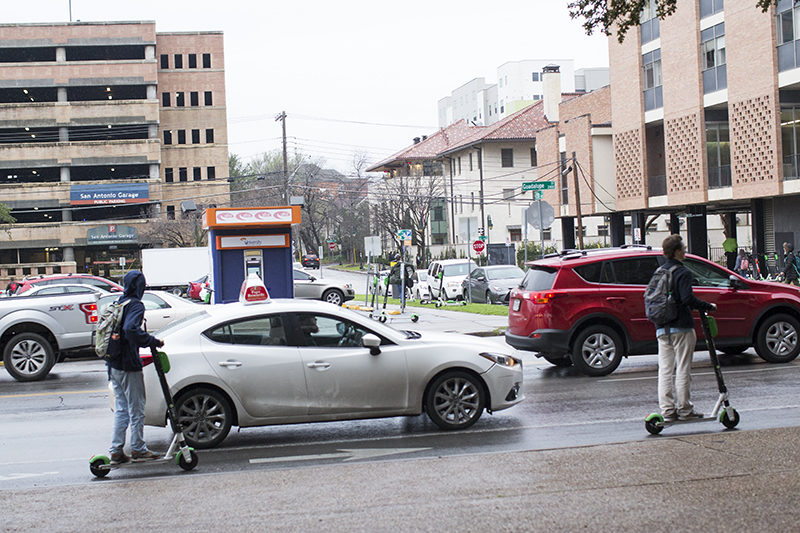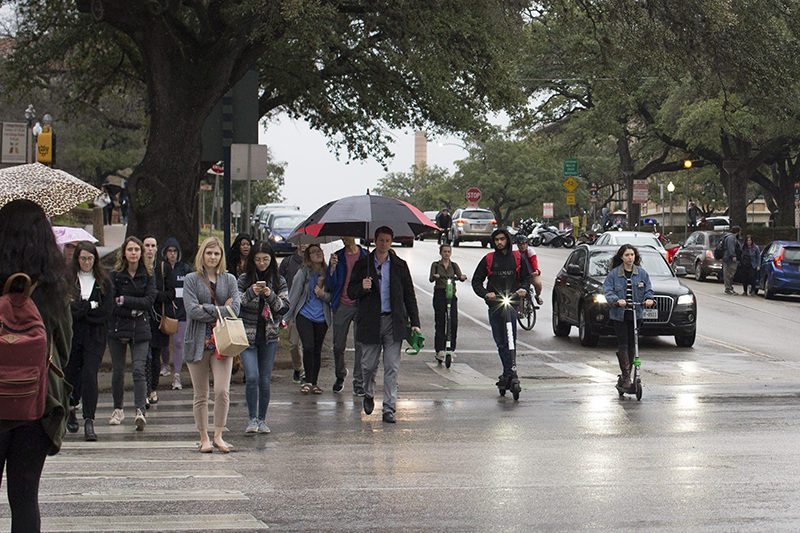UT Slows Down the Scooters, Students Don’t Seem to Mind
By Reid Jowers
Reporting Texas

People ride scooters on Guadalupe Street on the University of Texas-Austin campus. Cristina Pop/Reporting Texas
In January, the University of Texas at Austin implemented a new rule for on-campus dockless electric scooters — they would have to be parked in specific areas so as not to impede access to public spaces. The university promised other measures would follow pending further study.
The next one came in March — an 8-mph speed limit in certain areas of campus. Scooters breaking the limit trigger a geofence, a virtual boundary around a real-world location that gradually slows them down.
In a series of 10 interviews in April, most UT-Austin students said they welcome the automatically enforced speed limit, while one viewed the measure as unnecessary.
Will Damron, a sophomore economics major, says he witnessed a scooter collide with a truck near the Perry Castaneda Library on 21st Street and University Avenue.
“The truck was pulling out onto 21st, and the scooter came out of nowhere and hit it before either could stop.” Damron said. “The speed limits are a step in the right direction, but there needs to be more.”
Melissa Loe, Director of Communications for UT-Austin’s Financial and Administrative Services, says the new regulation has a simple goal — to keep people safe.
“Geofencing is a precautionary measure to help keep everyone safe. All currently permitted scooter companies – Bird, Jump, Lime and Lyft – operating on campus have the ability to [use] geofencing capabilities to [slow down scooters to] 8-mph in certain defined areas across campus,” Loe said via email.
Lloyd Gumireddy, a senior computer science major, says he doesn’t much mind the speed limit, but it’s probably unnecessary. “I don’t think they’re that much of a nuisance to set speed limits for them. I’ve never seen an accident between two riders, most seem to be self-inflicted by driving over a pothole or something and falling off.”

Scooters are seen on the University of Texas-Austin campus. Cristina Pop/Reporting Texas
Scoot Networks, a company in San Francisco, developed dockless scooters, offering them for commercial use in 2017 in San Francisco, Washington D.C. and Los Angeles. During the next two years, they expanded to other cities in the U.S. and Europe, eventually making their way to Austin. In April 2018, scooter companies Bird and Lime launched 700 and 200 scooters, respectively, in the city. Most were stationed downtown, but it didn’t take long for some to relocate on UT-Austin’s campus.
Criticism and concerns towards scooters largely come from the accidents that they cause. For every 100,000 scooter rides, 20 result in an accident, according to a study from the Centers for Disease Control and Prevention and the Austin Public Health Department.
Responding to safety concerns, UT-Austin’s Parking and Transportation Services and the City of Austin quickly drafted their first rules for scooters in May 2018. In November 2018, UT-Austin formed a Scooter Safety Management Workgroup which developed the parking and speed regulations.
According to Blanca Gamez, Assistant Director of Parking and Transportation Services, most of UT-Austin’s scooter policies came from examining other universities’ policies. For example, the University of California Santa Barbara has an 8-mph scooter speed limit, and Michigan State University prohibits driving them on sidewalks.
“These policies are mainly for Speedway Plaza, where at certain times during the day hundreds of students mix with cyclists, skateboards and scooters,” Gamez said. Besides Speedway, MLK Boulevard to Dean Keaton Street and smaller streets on campus are also geofenced zones.
The speed limit does not apply to all of campus. When the policies rolled out in March, areas such as San Jacinto Boulevard were allowed to keep a maximum speed of 15 mph due to the high volume of vehicle traffic there. Some UT-Austin buildings north of Dean Keaton, such as the Belo Center for New Media and the McKetta Department of Chemical Engineering, are outside traditional campus boundaries and therefore not subject to policy. According to Gamez, scooter policies are focused more on the core campus, even though these buildings are university property.
According to Noelle Newton, Director of Campus Safety Communications for UT-Austin Police Department, the university is unaware of any issues with geofencing. Signage at major campus entry points alert riders approaching a speed zone boundary to expect a gradual change in scooter speed.
Newton also says that UTPD currently cannot issue citations to riders for breaking the speed limit, only for reckless behavior as defined by state traffic laws, such as running a stop sign or driving on a sidewalk with high pedestrian traffic. This is because scooters don’t show up on speed radar, so enforcement is largely complaint-driven or trusted to geofencing.
Scooter companies operating on campus, Bird, Lime, Lyft and Jump, did not respond to multiple requests for comment about UT-Austin’s latest round of regulations.
Overall, the consensus among UT-Austin students seems to be that the scooter regulations are no big deal. Rolie Hernandez, a junior journalism and public relations major, says he doesn’t use scooters often but thinks setting rules for their use are in order.
“The speed limits and zoning [are] really important because of all the accidents,” Hernandez said. “A lot of my friends have told me about getting in accidents or nearly getting into ones, and that’s worrying.”